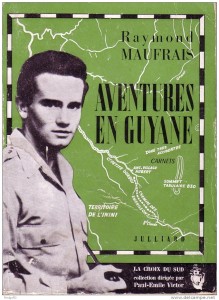 Raymond Maufrais (1926-50) was a French paratrooper, journalist and explorer. In September 1949 he attempted to travel solo from French Guyana to Brazil. His route would take him through the densely forested and sparsely populated Tumuk Humak mountain range. In February 1950 his notes and equipment were found in a hut by the River Tompok. Final entries show that the exhausted Maufrais intended to swim to the nearest habitation – a distance of some 70 km. His body was never found. His father Edgar journeyed to Guyana in 1952 and spent many years in South America, publishing an account of his search for his son – whose fate has never been determined – in 1956.)
Raymond Maufrais (1926-50) was a French paratrooper, journalist and explorer. In September 1949 he attempted to travel solo from French Guyana to Brazil. His route would take him through the densely forested and sparsely populated Tumuk Humak mountain range. In February 1950 his notes and equipment were found in a hut by the River Tompok. Final entries show that the exhausted Maufrais intended to swim to the nearest habitation – a distance of some 70 km. His body was never found. His father Edgar journeyed to Guyana in 1952 and spent many years in South America, publishing an account of his search for his son – whose fate has never been determined – in 1956.)
Thursday, 12th January [from the penultimate entry]
For a month now I’ve lived in the virgin forest, living entirely on what it provides and working hard meanwhile. And I’m nothing unusual, physically; I’m the average Frenchman – if that – the average European with his habits, his tastes, his modest scale of life – and his misadventures during the last twenty years. So that I’ve given the lie to those who asserted after their third round of punch that Guiana is “death to the European. He can’t exist in it without taking every possible precaution, keeping to a fixed diet, and avoiding physical effort. Hunting, for instance. You’ve got to go slow with your hunting; if you don’t, it’ll wear you to a shred. Kill you, in the end, it will”.
But Guiana is an unknown country. It’s not Guiana that kills the European, and it’s not hard, physical work, either. It’s the European who kills himself; and, as he needs an excuse, he pins the crime on Guiana.

